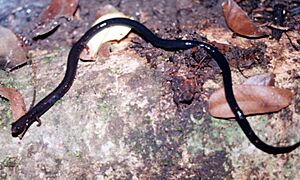Oedipina facts for kids
Quick facts for kids Oedipina |
|
|---|---|
 |
|
| Oedipina taylori | |
| Scientific classification |
|
| Kingdom: | Animalia |
| Phylum: | Chordata |
| Class: | Amphibia |
| Order: | Urodela |
| Family: | Plethodontidae |
| Subfamily: | Hemidactyliinae |
| Genus: | Oedipina Keferstein, 1868 |
| Species | |
|
See table. |
|
Oedipina is a special group of salamanders. They are often called worm salamanders because they are very thin and look a bit like worms! These amazing creatures don't have lungs. Instead, they breathe right through their skin and the lining of their mouths. You can find Oedipina salamanders in places like Honduras, Colombia, Costa Rica, Ecuador, and Mexico.
Contents
Discovering Worm Salamanders
Worm salamanders are truly unique animals. Unlike most creatures, they don't have lungs to breathe. Imagine breathing only through your skin! That's how these salamanders get their oxygen. They also use the moist tissues inside their mouths to help them breathe. This special way of breathing means they need to live in damp places.
Where Do They Live?
These interesting salamanders are found only in certain parts of the world. They live in Central and South America. You can find them in countries like Honduras, Colombia, Costa Rica, Ecuador, and Mexico. Each species of Oedipina might prefer a slightly different habitat. Some live in forests, while others might be found near streams or under logs.
Their Unique Look
The name "worm salamanders" fits them perfectly. They have very long, slender bodies. Their legs and toes are tiny, which makes them look even more like worms. This body shape helps them move easily through small spaces. They can hide under rocks or burrow into the soil. This keeps them safe from predators and helps them stay moist.
Many Types of Worm Salamanders
There are many different kinds of Oedipina salamanders. Scientists have discovered about 40 different species in this group! Each species has its own scientific name and sometimes a common name too. For example, there's the Limon worm salamander and Allen's worm salamander.
How Scientists Find New Species
Scientists are always exploring and finding new animals. When they find a new type of Oedipina, they study it carefully. They look at its body, where it lives, and even its DNA. If it's different enough from other known species, they give it a new scientific name. This helps us understand all the amazing life on Earth.

